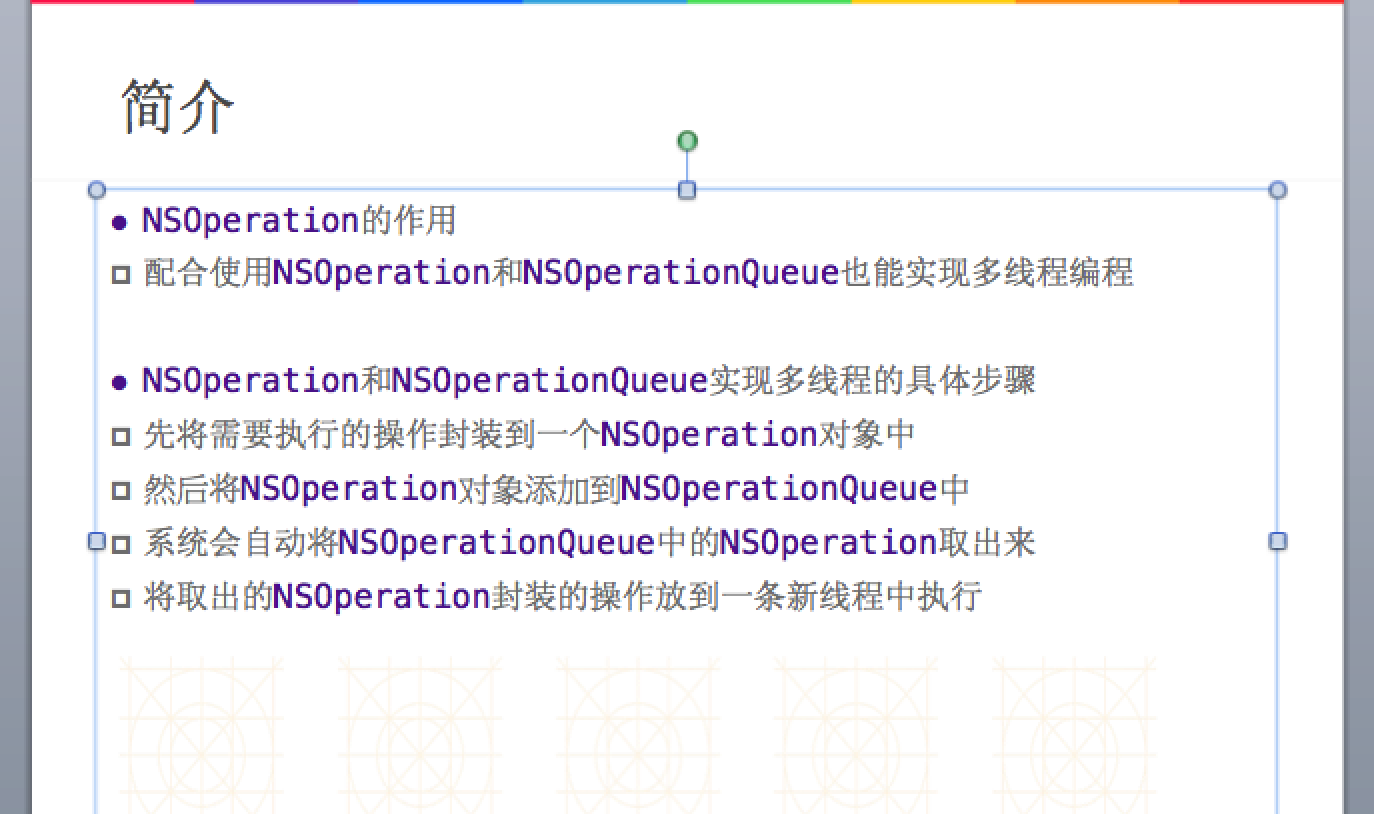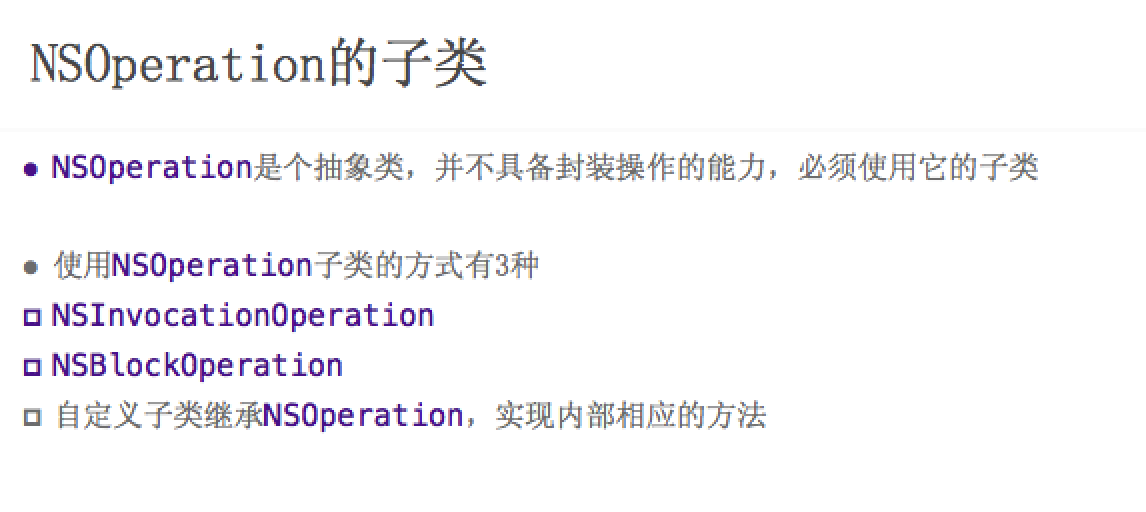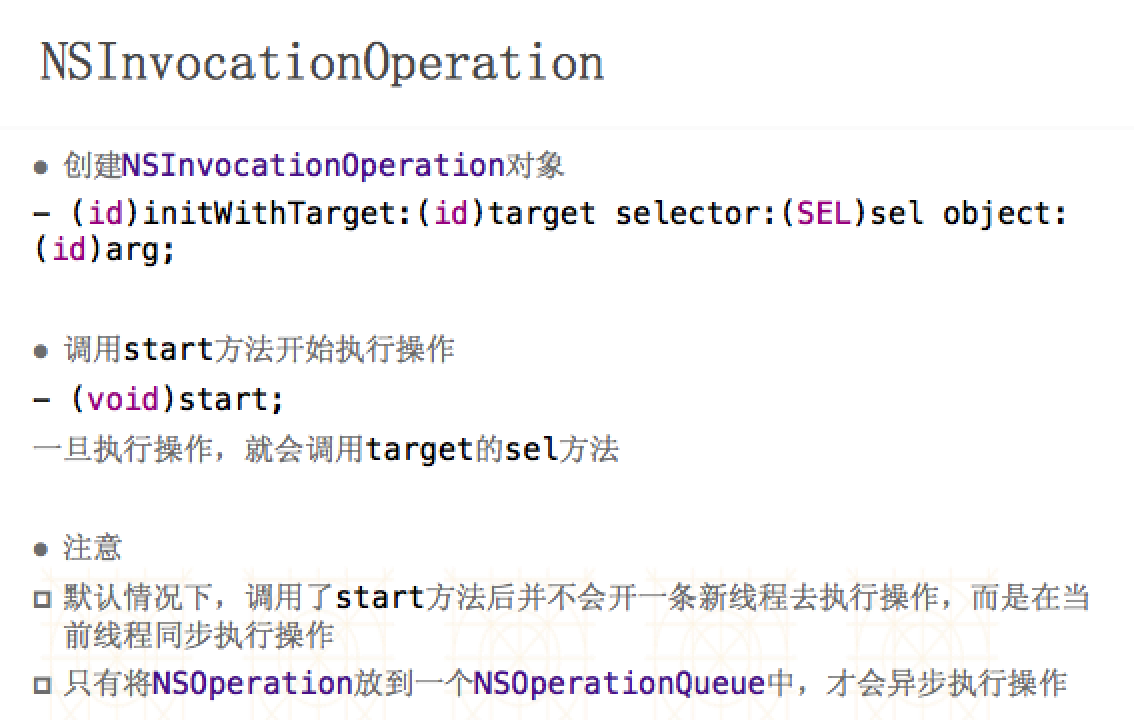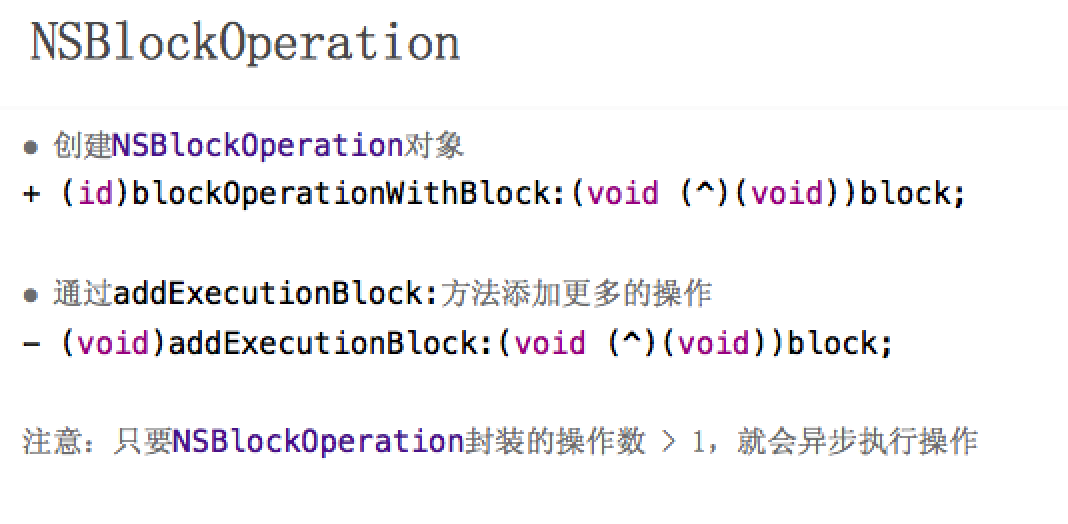



#import "ViewController.h" @interface ViewController () @end @implementation ViewController -(void)touchesBegan:(NSSet<UITouch *> *)touches withEvent:(UIEvent *)event { [self blockOperation]; } /** * 1:NSOperation封装任务的两种方式:NSInvocationOperation,NSBlockOperation,其中两种方法若没指定队列,则默认是在主队列里去执行 2:住家任务:addExecutionBlock: 注意:如果一个操作中的任务数量大于1,那么会开子线程并发执行任务 注意:不一定是子线程,有可能是主线程 */ -(void)invocationOpeation { //1.创建操作,封装任务 /* 第一个参数:目标对象 self 第二个参数:调用方法的名称 第三个参数:前面方法需要接受的参数 nil */ NSInvocationOperation *op1 = [[NSInvocationOperation alloc]initWithTarget:self selector:@selector(download1) object:nil]; NSInvocationOperation *op2 = [[NSInvocationOperation alloc]initWithTarget:self selector:@selector(download2) object:nil]; NSInvocationOperation *op3 = [[NSInvocationOperation alloc]initWithTarget:self selector:@selector(download3) object:nil]; //2.启动|执行操作 [op1 start]; [op2 start]; [op3 start]; } -(void)blockOperation { //1.创建操作 NSBlockOperation *op1 = [NSBlockOperation blockOperationWithBlock:^{ NSLog(@"1----%@",[NSThread currentThread]); }]; NSBlockOperation *op2 = [NSBlockOperation blockOperationWithBlock:^{ NSLog(@"2----%@",[NSThread currentThread]); }]; NSBlockOperation *op3 = [NSBlockOperation blockOperationWithBlock:^{ NSLog(@"3----%@",[NSThread currentThread]); }]; //追加任务 //注意:如果一个操作中的任务数量大于1,那么会开子线程并发执行任务 //注意:不一定是子线程,有可能是主线程 [op3 addExecutionBlock:^{ NSLog(@"4---%@",[NSThread currentThread]); }]; [op3 addExecutionBlock:^{ NSLog(@"5---%@",[NSThread currentThread]); }]; [op3 addExecutionBlock:^{ NSLog(@"6---%@",[NSThread currentThread]); }]; //2.启动 [op1 start]; [op2 start]; [op3 start]; } -(void)download1 { NSLog(@"%s----%@",__func__,[NSThread currentThread]); } -(void)download2 { NSLog(@"%s----%@",__func__,[NSThread currentThread]); } -(void)download3 { NSLog(@"%s----%@",__func__,[NSThread currentThread]); } @end
###2.NSOperation
- 2.1 NSOperation基本使用
(1)相关概念
01 NSOperation是对GCD的包装
02 两个核心概念【队列+操作】
(2)基本使用
01 NSOperation本身是抽象类,只能只有它的子类
02 三个子类分别是:NSBlockOperation、NSInvocationOperation以及自定义继承自NSOperation的类
03 NSOperation和NSOperationQueue结合使用实现多线程并发
(3)相关代码
```objc
// 01 NSInvocationOperation
//1.封装操作
/*
第一个参数:目标对象
第二个参数:该操作要调用的方法,最多接受一个参数
第三个参数:调用方法传递的参数,如果方法不接受参数,那么该值传nil
*/
NSInvocationOperation *operation = [[NSInvocationOperation alloc]
initWithTarget:self selector:@selector(run) object:nil];
//2.启动操作
[operation start];
-------------------------------------------------
// 02 NSBlockOperation
//1.封装操作
/*
NSBlockOperation提供了一个类方法,在该类方法中封装操作
*/
NSBlockOperation *operation = [NSBlockOperation blockOperationWithBlock:^{
//在主线程中执行
NSLog(@"---download1--%@",[NSThread currentThread]);
}];
//2.追加操作,追加的操作在子线程中执行
[operation addExecutionBlock:^{
NSLog(@"---download2--%@",[NSThread currentThread]);
}];
[operation addExecutionBlock:^{
NSLog(@"---download3--%@",[NSThread currentThread]);
}];
//3.启动执行操作
[operation start];
----------------------------------------------
// 03 自定义NSOperation
//如何封装操作?
//自定义的NSOperation,通过重写内部的main方法实现封装操作
-(void)main
{
NSLog(@"--main--%@",[NSThread currentThread]);
}
//如何使用?
//1.实例化一个自定义操作对象
XMGOperation *op = [[XMGOperation alloc]init];
//2.执行操作
[op start];
```